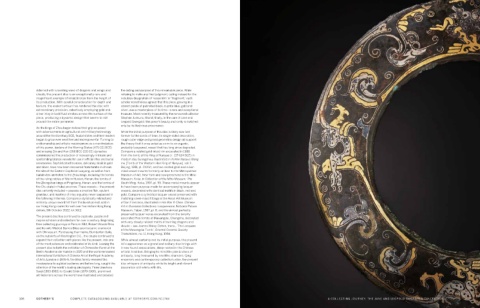Page 55 - SOTHEBYS MARCH 18 AND 19 2025
P. 55
Adorned with a swirling wave of dragons and wings and the dating and purpose of this remarkable piece. While
clouds, the present disc is an exceptionally rare and refusing to make any final judgment, opting instead for the
magnificent example of inlaid bronze from the height of nebulous designation of ‘vessel rim’ or ‘fragment,’ each
its production. With careful consideration for depth and scholar nonetheless agreed that this piece, glowing in a
texture, the ancient artisan has rendered the disc with vibrant palate of patinated black, cuprite blue, gold and
extraordinary precision, selectively employing gold and silver, was a masterpiece of its time– a rare and exceptional
silver inlay in bold fluid strokes across the surface of the treasure. Most recently treasured by the renowned collector
piece, producing a dynamic design that seems to roll Stephen Junkunc, III and, finally, in the care of Jane and
around the entire perimeter. Leopold Swergold, this piece’s beauty and rarity is matched
only by its illustrious provenance.
As the kings of Zhou began to lose their grip on power
with advancements in agricultural and military technology While the initial purpose of this disc is likely now lost
around the third century BCE, feudal states and their leaders forever to the sands of time, its single-sided decoration,
began to grow ever wealthier and more powerful. Turning to rough outer edge and grand geometric design all support
craftsmanship and artistic masterpieces as a manifestation the theory that it once acted as a rim to an organic,
of this power, leaders of the Warring States (475-221 BCE) probably lacquered, vessel that has long since degraded.
and ensuing Qin and Han (206 BCE-220 CE) dynasties Compare a related gold-inlaid rim excavated in 1988
commissioned the production of increasingly intricate and from the tomb of the King of Nanyue (r. 137-124 BCE) in
spellbinding bronze vessels for use in official rites and burial modern day Guangzhou, illustrated in Xi Han Nanyue Wang
ceremonies. Sophisticated bronzes, delicately inlaid in gold mu [Tomb of the Western Han King of Nanyue], vol. II,
and silver, have now been recovered from tombs in Jincun, Beijing, 1991, pl. CXXVI; and two related gold-and-silver-
the site of the Eastern Capital at Luoyang, as well as from inlaid vessel mounts formerly on loan to the Metropolitan
burial sites unrelated to the Zhou kings, including the tombs Museum of Art, New York and now preserved in the Miho
of the ruling nobles of Wei in Huixian, Henan, the tombs of Museum, Koka, in Collection of the Miho Museum: The
the Zhongshan kings at Pingcheng, Henan, and the tombs of South Wing, Koka, 1997, pl. 99. These metal mounts appear
the Chu state in Hubei province. These vessels – the present to have been purpose-made for accompanying lacquer
disc certainly included – possess a creative flair, opulent vessels, decorated with identical motifs in black, red and
grandeur, and mastery of inlay arguably never surpassed in gold. Compare a cylindrical lacquer vessel preserved with
the following millennia. Compare a stylistically related and matching silver-inlaid fittings in the Asian Art Museum
similarly unique sword hilt from this lavish period, sold in of San Francisco, illustrated in Hai-Wai Yi-Chen. Chinese
our Hong Kong rooms for well over five million Hong Kong Art in Overseas Collections: Lacquerware, National Palace
dollars, 9th October 2022, lot 3612. Museum, Taipei, 1987, pl. 8; and the almost perfectly
preserved lacquer wares excavated from the lavishly
The present disc has continued to captivate, puzzle and decorated Han tombs at Mawangdui, Changsha, decorated
inspire scholars and collectors for over a century. Beginning with very closely related motifs of swirling dragons and
their collecting journeys in Paris in 1912, Robert Woods Bliss clouds – see Joanna Waley-Cohen, trans., ‘The Lacquers
and his wife Wildred Barnes Bliss soon became enamored of the Mawangdui Tomb’, Oriental Ceramic Society
with Chinese art. Purchasing their home, Dumbarton Oaks, Translations, no. 11, Hong Kong, 1984.
on the outskirts of Washington D.C., the couple continued to
expand their collection with pieces like the present, into one While almost certainly not its initial purpose, the present
of the most extensive and celebrated of its kind. Loaning the lot’s appearance as a grand and solitary disc brings with
present disc to both the exhibition of Chinesiche Kunst at the it new-found associations, deep-rooted in the Chinese
Berlin Akademie der Künste in 1929 and the world-renowned artistic tradition. Bringing to mind the jade bi discs of
International Exhibition of Chinese Art at the Royal Academy antiquity, long treasured by neolithic shamans, Qing
of Arts, London in 1935-6, the Bliss family revealed this emperors and contemporary collectors alike, the present
masterpiece to a global audience and before long, caught the disc whispers of antiquity while its bright and vibrant
attention of the world’s leading sinologists. From Umehara decoration still whirls with life.
Sueji (1893-1983) to Osvald Sirén (1879-1966), prominent
art historians across the world have illustrated and debated
106 SOTHEBY’S COMPLETE CATALOGUING AVAILABLE AT SOTHEBYS.COM/N11744 A COLLECTING JOURNEY: THE JANE AND LEOPOLD SWERGOLD COLLECTION

